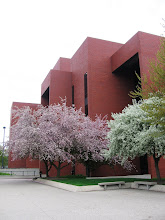Ball State University Libraries Complete Another Excellent Semester

A Selection of the University Libraries Fall 2007 Accomplishments
Over the past three months, University Libraries’ personnel have completed a large number of important projects that benefit our students and faculty. This is a small, representative selection:
Public Services
· Renovation of public space, including revamping of the Science-Health Science Library with the addition of several PC computers and a new circulation counter; the addition of study space in Bracken Library on 1W through the removal and relocation of shelving, expansion of casual study space in the Educational Resources Collections, relocation of shelving from the first floor to the second and third floors to ease space constraints
· New outreach efforts including library instruction workshops in selected residence halls, Scheidler Apartments, for transfer students, expansion of the library liaison program, and additions or enhancements to social networking vehicles such as blogs, live chat, and wikis
· Expansion of online independent tutorials and research assistance, including tutorials created with Camtasia and Mediasite and the addition of upgraded and/or new research guides using LibGuides, which provides a contemporary look and powerful organizational tool to aid students in independently researching popular topics
Collections Resources Management
· Provided access to new electronic resources, including JSTOR’s Arts and Sciences V Collection, Westlaw Campus, and additional Web of Science backfiles (back to 1987); identified and established online access to nearly 1,000 open access journals
· Created over 40,000 digital objects for the Digital Media Repository, Ball State Virtual Press and other online collections
· Enhanced access and ease of browsing to the Educational Resources’ realia and picture collections through the addition of over 4,000 thumbnail images to records in the public catalog, CardCat
· Added Ball State’s symbol to OCLC records for over 158,000 items held by Ball State University Libraries that were not accessible in WorldCat given that the online cataloging was generated by commercial vendors in order to facilitate interlibrary loan and collection analysis functions
· Initiated bar coding of cataloged materials in Archives and Special Collections, applying 12,250 barcodes and linking over 8,100 items in Sirsi, the University Libraries’ integrated information system
Library Information Technology Services
· Updated the University Libraries' Public Access Computer (PAC) configuration to include Adobe Creative Suite CS3 (Acrobat Pro 8, Contribute 8, Designer 8, Dreamweaver CS3, Flash Pro CS3, Illustrator CS3, InDesign CS3, Photoshop CS3), and Microsoft Office 2007, and supported updated versions of SPSS, Minitab, Mathematica, and popular instant messaging programs
· Installed and configured the LIBGUIDES service to provide better access for students and faculty to information resources through dynamic subject/research guides
· Prepared a system platform to support the launch of Cardinal Scholar, the Ball State University Institutional Repository
· Identified and implemented eight changes to the public online catalog, CardCat, to facilitate easier use and greater access to the Libraries’ informational resources
Archives and Special Collections
· Increased the number of instructional sessions by 28% (27 classes) and increased the number of students reached through instructional sessions by 40% (538 students) in fall 2007 compared to fall 2006
· Participated in two new initiatives to promote scholarship on Nobel Prize winning author John Steinbeck and thereby increased the use of the University Libraries’ nationally recognized Steinbeck Collection
Premiered an enhanced Web site with several new resources, including an alumni resources page,
· instructional sessions information and scheduling forms, an Ask an Archivist link, and direct links to digital collections
Digital Initiatives & Institutional Repositories
· Increased by 10,648 the number of digital objects in the Digital Media Repository and added seven new digital collections in fall 2007
· Digitized issues of the Muncie Post-Democrat, an anti-Ku Klux Klan newspaper from the 1920s through the 1950s by means of a Library Services and Technology Digitization Grant (LSTA)
· Developed Cardinal Scholar, the Ball State institutional repository, as an important element of the university’s research publishing distribution strategies
· Created a presence in Second Life’s virtual world in order to explore ways to provide access to information resources and reference assistance to students and faculty within this virtual world
Technology Training Support Services
· Taught 193 training sessions attended by 283 faculty and graduate students and by 256 staff, covering topics such as Microsoft Office Productivity, instructional technology, media and design, and campus utilities
· Provided 116 one-on-one consultation sessions for faculty and staff and 24 student training workshops at faculty request for digital portfolio development, Web site creation, creating instructional brochures
Geospatial Resources and Map Collection
· Increased the number of instructional sessions to 21 classes, up 133%, and increased the number of students reached through the instructional sessions by 47% compared to the same period a year ago
· Added a number of new GIS and online resources, including Business MAP software, Delaware County oblique aerial photography, three new online map tutorials, an online Google map of visitors to the University Libraries, and an online resource on the history of the White River
Copyright and Intellectual Property Office
· Created the Copyright for Distance Educators homepage
· Expanded the Ball State Virtual press with new faculty and student audiovisual content
Commitment to Providing High Quality Services
These accomplishments, along with several others that I have not mentioned and those that will be completed between now and the end of the fiscal year in June 2008, are evidence of the commitment by the University Libraries’ professional and paraprofessional personnel to continually improve the Libraries’ programs, services, and collections to provide outstanding and uniformly gracious, friendly services to our students and faculty.
By creating, developing, adapting, and implementing innovative and creative technologies, products, and services that support the research, learning, and classroom engagement, the University Libraries support Ball State University as it moves toward national prominence in teaching, research, and service.



